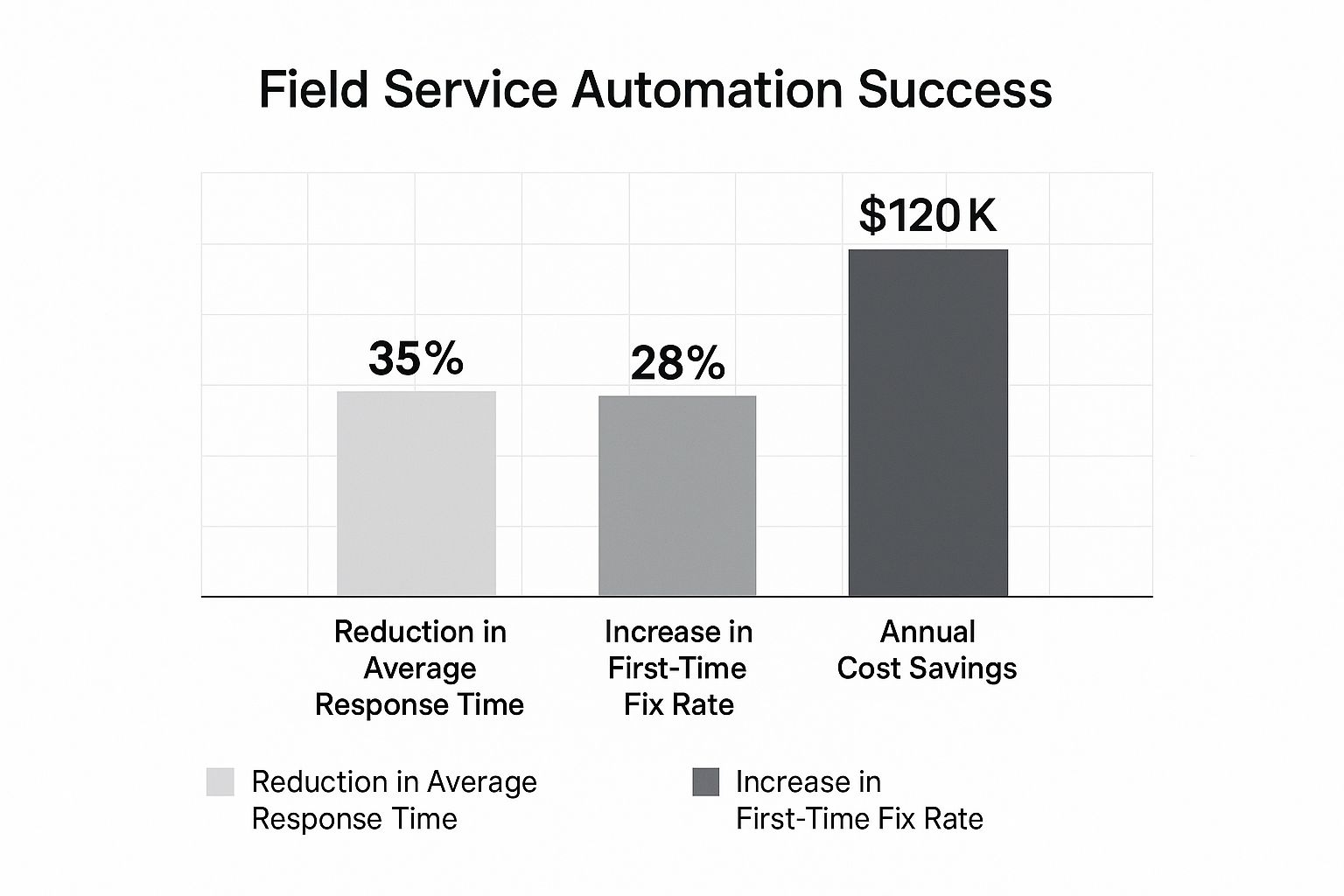Field Service Automation: The Complete Guide to Growth
- Matthew Amann

- Jun 2
- 12 min read
What Makes Field Service Automation Actually Work
Field service automation is more than just going paperless. It's about creating a smooth, integrated system that connects field technicians, back-office staff, and customers. This interconnectedness is the key to unlocking real operational efficiency. Think of it as an orchestra: individual instruments (your technicians, dispatch, customer service) are talented on their own, but the real magic happens when they play together harmoniously, guided by a conductor (your automation system).
Core Components of Successful Automation
This harmony depends on a few core components. First, mobile apps are crucial for empowering field technicians. These apps must be intuitive and easy to use, providing real-time access to schedules, job details, and customer information. Imagine a technician arriving at a job site already equipped with the customer's history, specific equipment needs, and even optimized driving directions. This eliminates wasted time and boosts first-time fix rates.
GPS tracking also plays a vital role. It optimizes routes and dispatches the nearest available technician, saving on fuel costs and enabling faster response times—a critical factor for customer satisfaction. It's similar to a ride-sharing app, but for your field service team, constantly optimizing for the quickest, most efficient routes.
Finally, customer portals empower customers to track service requests, communicate with technicians, and access invoices without needing to call. This self-service approach frees up your team to focus on other tasks and substantially enhances the customer experience.
Beyond the Basics: Integrations and Data
Simply having these components isn’t enough. True field service automation needs seamless integration with existing systems. Your ERP, CRM, and inventory systems need to communicate with each other, creating a single source of truth. This means when a technician updates a job status in the field, the information automatically updates across all relevant systems, eliminating data silos and improving communication.
This interconnectedness generates a wealth of data that can be used to further optimize operations. For example, analyzing data on common equipment failures enables you to implement predictive maintenance schedules, preventing expensive downtime. This is where field service automation shifts from reactive to proactive, anticipating and solving problems before they occur. This shift allows for more strategic decision-making, optimized resource allocation, and ultimately, significant cost savings. This proactive approach is increasingly vital for competitive service organizations.
Why Smart Companies Are Racing To Automate

The field service automation sector is experiencing significant growth. Forward-thinking companies are quickly integrating automation into their operations, influenced by powerful market dynamics and advancements in technology. This rapid adoption is more than a passing trend; it's a strategic shift in response to evolving operational demands.
The Rise of Customer Expectations
Modern customers anticipate quick responses, transparent communication, and personalized services. Meeting these elevated expectations necessitates a level of efficiency and responsiveness that traditional manual processes often struggle to provide. Automation equips service organizations to offer seamless, real-time updates, proactive communication, and tailored experiences that cultivate customer loyalty.
Technological Advancements Driving Change
This transformation is powered by innovative technologies. Artificial intelligence, IoT sensors, and augmented reality are no longer concepts of the future; they are practical tools that optimize operations and improve service delivery. For instance, AI-driven predictive maintenance can anticipate equipment malfunctions, minimizing downtime and boosting efficiency. This proactive service approach provides a considerable advantage for businesses that embrace it early.
From Reactive to Predictive: A Competitive Edge
The shift from reactive service models, where technicians respond to emergencies, towards predictive, data-driven service creates a substantial competitive advantage. This proactive strategy minimizes disruptions, optimizes resource allocation, and ultimately reduces costs. This transition is essential for any service organization striving to succeed in a competitive market. The global field service management (FSM) market, a key component of field service automation, was valued at approximately $6 billion USD in 2024. Projections indicate it will reach $11.5 billion USD by 2030, reflecting a compound annual growth rate (CAGR) of 11.4%. This rapid growth stems from the increasing demand for real-time operational visibility, automated workforce management, and improved customer experiences. For more comprehensive data, see: Field Service Management Market Statistics
The Push for Automation: Market Trends
Several other elements contribute to the increasing investment in automation. The growing prevalence of subscription-based business models requires efficient and scalable service operations. Furthermore, blockchain integration enhances security and transparency within the field service industry. For further insights, consider exploring: Top Business Automation Services To Transform Your Business. These converging trends are reshaping the operational landscape of service companies, making automation an essential component for growth-oriented organizations. Delaying automation is no longer a viable strategy for businesses pursuing sustained success in the dynamic field service sector.
The Real ROI That Nobody Talks About

Field service automation delivers a tangible return on investment (ROI) that goes beyond simple cost reductions. It transforms how service businesses operate, impacting the entire organization. This improved ROI influences crucial areas like first-time fix rates and customer satisfaction, leading to measurable business performance improvements.
Beyond Cost Savings: Transforming Business Models
Cost savings are important, but the true strength of field service automation lies in its ability to reshape business models. Optimized routing, for example, not only minimizes fuel consumption but also enables technicians to handle more jobs daily. This increased capacity boosts revenue potential and contributes directly to a healthier bottom line.
Automation facilitates real-time information access, empowering technicians with the knowledge to diagnose and resolve problems efficiently. This directly improves first-time fix rates, leading to happier customers and fewer return visits, creating a ripple effect of positive outcomes.
Measuring Success: The Metrics That Matter
Many companies use automation to enhance their sales pipelines. For example, explore how outbound sales automation can significantly improve sales performance. Successful organizations track essential metrics to gauge the effectiveness of their automation investments. This data-driven approach helps pinpoint areas for improvement and showcases the value of automation to stakeholders.
These metrics go beyond obvious financial gains. Improved employee retention is a significant, often overlooked, benefit of automation. By streamlining workflows and reducing administrative tasks, automation allows technicians to focus on their core skills, leading to greater job satisfaction and lower turnover. Discover more in this article on How to master business process automation. This, in turn, contributes to enhanced service quality and customer satisfaction.
Building a Compelling Business Case for Automation
A compelling business case is essential for securing executive buy-in and organizational support for automation. This case should detail the measurable benefits, from cost savings and productivity gains to higher customer satisfaction and improved employee morale. It should also address potential challenges and offer solutions for mitigating risks.
By demonstrating the real value of field service automation, organizations can build a solid foundation for successful implementation and sustained growth. This involves highlighting not just the immediate cost reductions, but also the long-term effects on brand reputation and competitive advantage.
Building Your Automation Technology Stack
Modern field service automation depends on choosing the right technology and integrating it effectively. This means selecting tools that meet your current needs and also adapt to future growth and technological advancements. It's like building a house: a strong foundation is crucial for future expansions and renovations.
Key Components of a Modern Automation System
The foundation of any successful field service automation strategy includes these core components:
Mobile Applications: Providing field technicians with easy-to-use mobile apps gives them real-time access to job details, schedules, and customer information. This helps them work more efficiently and reduces the constant need to contact the office.
Cloud Platforms: Cloud-based solutions offer scalability and flexibility, allowing your system to grow with your business. They also enable real-time data sharing and collaboration between field technicians and office staff.
Integration with Existing Systems: Integrating seamlessly with your current ERP, CRM, and inventory systems is essential. This eliminates data silos, ensures data consistency, and offers a complete overview of your operations.
To help visualize the different technology components and their functionalities, the table below provides a detailed comparison across different platforms:
Field Service Automation Technology Stack Comparison: Comparison of essential technology components and their features across different automation platforms.
Technology Component | Core Features | Integration Capabilities | Implementation Complexity |
|---|---|---|---|
Mobile Applications | Job scheduling, dispatching, real-time updates, customer information access, parts ordering | Integration with CRM, ERP, and inventory management systems | Relatively low, depending on integration needs |
Cloud Platforms | Data storage, analytics, reporting, user management, security | APIs for custom integrations, pre-built connectors for common systems | Moderate, depending on the chosen platform and customization requirements |
AI-Powered Scheduling | Route optimization, predictive maintenance, automated dispatching | Integration with mapping services, IoT sensors, and field service management software | High, requires significant data input and algorithm training |
Key takeaways from this comparison include the increasing importance of integration capabilities and the varying levels of implementation complexity associated with different technology components. Understanding these differences is crucial for making informed decisions about your automation strategy.
The Power of AI and Emerging Technologies
Beyond these fundamental components, emerging technologies are playing a growing role in field service automation:
Artificial Intelligence (AI): AI improves predictive maintenance, letting you foresee equipment failures and schedule preventative maintenance proactively. This reduces downtime and optimizes resource allocation.
Machine Learning (ML): ML algorithms improve scheduling by analyzing historical data and real-time conditions. This ensures the right technician is assigned to the right job at the right time, improving efficiency and reducing travel time.
Augmented Reality (AR): AR is changing on-site service delivery by giving technicians real-time access to remote expert assistance, schematics, and repair instructions. This improves first-time fix rates and reduces repeat visits.

The infographic above shows the impact of field service automation on key performance indicators. It visualizes the percentage reduction in average response time, the increase in first-time fix rate, and the annual cost savings from automation. Implementing automation can significantly reduce response time, substantially increase first-time fixes, and lead to considerable cost savings.
Security and Data Integrity
When building your automation technology stack, security and data integrity are paramount. Make sure your chosen platforms follow industry best practices for data encryption and access control. Maintaining data integrity across different platforms is essential for accurate reporting, informed decision-making, and building customer trust. Careful planning and execution ensure that your automation system not only improves efficiency but also protects sensitive data. Selecting the right tools and implementing them strategically is key for long-term success in field service operations.
Implementation That Actually Succeeds
Successfully automating field services isn't about having the newest technology. It's about using it effectively. This involves a strategic approach, thorough planning, and a deep understanding of your organization’s needs. Think of it like constructing a building: a strong foundation is crucial for long-term stability and expansion.
Needs Assessment and Deployment Strategy
Start with a comprehensive needs assessment to pinpoint where automation will make the biggest difference. This includes analyzing current workflows, identifying bottlenecks, and understanding the difficulties faced by both field technicians and back-office staff. For example, if scheduling is a major problem, focus on automating dispatch and routing.
Next, choose the best deployment strategy: a phased rollout or a comprehensive deployment. Phased rollouts let you test the system in a controlled environment, minimizing disruptions and gathering valuable feedback. Comprehensive deployments are faster but require more initial planning and coordination.
Critical Success Factors: Change Management and Training
Successful implementation depends on effective change management. Clearly communicate the automation’s benefits to everyone involved and address any concerns proactively. This builds support and reduces resistance to change. It’s like introducing a new tool: everyone needs to understand its purpose and how it improves their work.
Robust training programs are crucial for ensuring technicians use the new systems effectively. Hands-on training, clear documentation, and ongoing support contribute to a smooth transition. When building your automation technology, consider platforms like Tevello that offer robust features, seamless integrations, and a user-friendly experience.
Project Management, Risk Mitigation, and Performance Monitoring
Implement a structured project management framework to oversee the implementation process, monitor progress, and ensure deadlines are met. Identify potential risks and develop strategies to address them. For example, you can mitigate data migration issues by cleaning and validating data before implementation. For more information on inventory management, read our article on How to master automated inventory management.
Performance monitoring is essential for evaluating the automation system’s effectiveness. Track key metrics like first-time fix rates, response times, and customer satisfaction to identify areas for improvement. Regular reviews and adjustments ensure the system delivers the expected return on investment.
Ongoing Optimization and Maintaining Momentum
After launch, maintain momentum by regularly reviewing and optimizing the system. Gather user feedback, analyze performance data, and adjust workflows as needed. This ensures your field service automation solution continues to evolve and meet your changing business needs. By focusing on these key areas, you can maximize the benefits of field service automation and achieve lasting results.
Advanced Strategies That Drive Real Growth

Mastering the basics of field service automation is just the first step. Building on this foundation, businesses can unlock the potential for advanced strategies that fuel sustained growth. These strategies move beyond simply automating schedules and dispatch to incorporate more sophisticated tools and processes.
Predictive Analytics and Intelligent Resource Allocation
Predictive analytics is transforming the field service industry. By analyzing historical data and real-time inputs, these systems can anticipate equipment failures before they occur. This allows for proactive maintenance, reducing downtime and optimizing resource allocation. Imagine predicting when a vital piece of machinery is likely to fail and scheduling maintenance to avoid costly disruptions.
Furthermore, intelligent resource allocation maximizes your team's expertise. By assigning the most qualified technician to each job, you ensure efficient service delivery and improve first-time fix rates. This leads to greater customer satisfaction and improved operational efficiency.
Seamless Customer Experiences
Leading organizations use automation to create exceptional customer experiences. Self-service portals empower customers to track their service requests, communicate with technicians, and access invoices at their convenience. This eliminates frustrating phone calls and provides immediate access to important information.
Automated communication workflows also play a key role. By automatically sending updates and notifications throughout the service process, businesses keep customers informed and engaged, contributing to a more satisfying and transparent customer journey.
Integration and Visibility
Integrating with existing business systems, such as CRM and ERP platforms, is crucial for success. Connecting these systems eliminates manual data entry, reduces errors, and creates a single source of truth for all service-related information.
This integration provides unparalleled visibility into service operations. Managers can track key metrics, identify bottlenecks, and optimize workflows. This comprehensive overview enables data-driven decision-making, promoting continuous improvement and operational excellence. The field service management (FSM) market is experiencing rapid growth, expanding from $4.55 billion USD in 2024 to a projected $9.07 billion USD by 2029, a 15.2% CAGR. Over 80% of corporate executives are increasing their investments in workflow automation. For more detailed statistics, see: Field Service Management Market Growth.
Scaling Efficiently With Automation
Automation enables efficient scaling by streamlining processes like billing and performance tracking. Subscription-based service models, powered by automated billing, generate recurring revenue and simplify customer management. Real-time performance dashboards provide immediate insights into key metrics, allowing managers to identify trends and optimize resource allocation as the business grows. This allows companies to expand rapidly while maintaining high service quality and customer satisfaction.
Building Systems That Grow With Your Business
Field service automation is more than just a quick fix for current issues; it's about laying the groundwork for future triumphs. This involves choosing systems that can adapt to your evolving business needs and seamlessly integrate new technologies as they appear. Think of it like planting a tree: select one that will flourish in its environment and grow stronger over time.
Choosing The Right Technology Partner
The first crucial step is choosing the right technology partner. Look for vendors with a clear innovation roadmap and a proven track record of supporting growing businesses. This ensures your chosen system won't quickly become outdated and can scale alongside your expanding operations. A reliable partner offers continuous support, regular updates, and a dedication to staying ahead of industry trends.
Staying Ahead Of The Curve
To stay competitive, you must anticipate industry trends. This means continuously evaluating new technologies and deciding strategically when to implement them. It's not about adopting every new gadget but about understanding how emerging solutions can tackle your specific business challenges and provide a measurable return on investment. For example, consider how advancements in AI-powered scheduling or AR-assisted repairs could benefit your field teams and improve customer satisfaction.
Preparing Your Workforce
Automation doesn't replace the human touch. Instead, it empowers your workforce to concentrate on tasks that require uniquely human skills, like building relationships and delivering personalized service. This means proactively preparing your team for an increasingly automated future. Offer training on new systems, highlight the importance of human interaction, and encourage employees to leverage automation to improve their work. Focusing on the human element sets your organization apart and builds strong customer loyalty.
Building Flexibility Into Your Systems
Adaptability is crucial for long-term success. Design your automation framework with flexibility in mind, allowing it to accommodate new features, integrations, and even evolving business models. Modular systems that can be easily customized and expanded offer the agility to respond to changing market conditions and customer expectations. This proactive approach minimizes the need for expensive overhauls later on, ensuring your investment continues to provide value.
To help illustrate the potential return on investment, let's look at some key metrics and industry benchmarks.
The table below provides a general overview of Field Service Automation ROI metrics. Actual results can vary widely depending on the specific industry, company size, and implementation strategy. It is crucial to conduct a thorough assessment of your own situation to develop realistic expectations.
Metric Category | Key Indicators | Industry Average | Best-in-Class Performance |
|---|---|---|---|
Operational Efficiency | Reduced service costs | 15-20% | 30-40% |
Operational Efficiency | Improved technician utilization | 10-15% | 25-30% |
Customer Satisfaction | Increased first-time fix rate | 5-10% | 15-20% |
Customer Satisfaction | Improved customer satisfaction scores | 2-5% | 10-15% |
Revenue Growth | Increased service revenue | 5-10% | 15-20% |
As the table shows, best-in-class performers significantly outperform the industry average across all key metrics. This highlights the potential for substantial gains through effective implementation of field service automation.
Ready to revolutionize your field service operations with intelligent automation? Flow Genius provides expert guidance and tailored solutions designed to grow with your business. Contact us today to learn more about how we can help you optimize your workflows, enhance customer experiences, and achieve sustainable growth. Discover the power of automation with Flow Genius.

Great points on why field service management software is so important today. At SuiteWorks Tech, we built the #NetSuite Field Service Management Mobile App to help businesses manage service requests, track vendor and in-house maintenance, and handle technician workflows — all directly within NetSuite, without extra licenses for field staff.